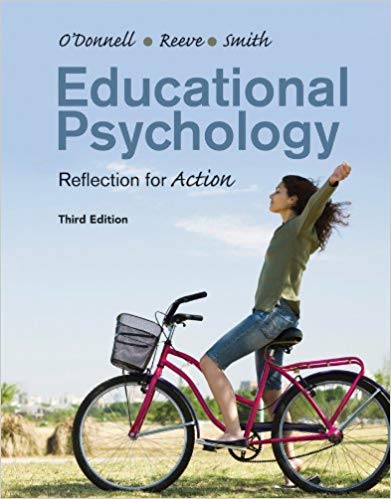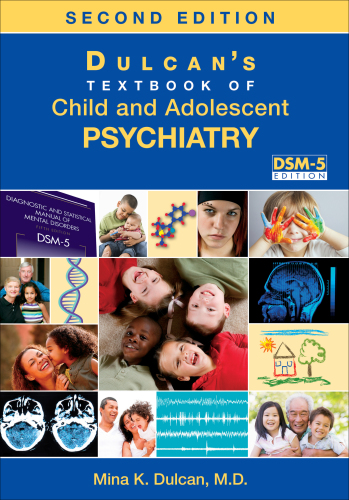O'Donnell's latest issue of Educational Psychology: Reflection for Action 3rd Edition has the reflective practice framework that teaches skills necessary to know how to connect the theory to various situations.
This issue teaches critical thinking and reflective practice skills that are essential to long-term success and growth. Reflective practice is woven throughout the text using real classroom examples, and features such as "Analyze This Lesson Plan" and "How Can I Use This" to encourage probing and examining in order to find a solution.
چکیده فارسی
آخرین شماره اودانل روانشناسی تربیتی: بازتاب برای عمل نسخه 3rd دارای چارچوب تمرین بازتابی است که مهارتهای لازم برای دانستن نحوه اتصال نظریه به انواع مختلف را آموزش میدهد. موقعیت ها.
این شماره مهارتهای تفکر انتقادی و تمرین تأملی را آموزش میدهد که برای موفقیت و رشد بلندمدت ضروری است. تمرین انعکاسی در سراسر متن با استفاده از مثالهای کلاس درس واقعی، و ویژگیهایی مانند «تحلیل این طرح درس» و «چگونه میتوانم از آن استفاده کنم» برای تشویق به جستجو و بررسی به منظور یافتن راهحل بافته میشود.
ادامه ...
بستن ...
Ebook details:
عنوان: Educational Psychology: Reflection for Action
نویسنده: Angela M. O'Donnell, Johnmarshall Reeve, Jeffrey K. Smith
ناشر: John Wiley & Sons; 3rd edition (December 6, 2011)
زبان: English
شابک: 1118076133, 978-1118076132
حجم: 235 Mb
فرمت: Image Pdf
ادامه ...
بستن ...
Title Page
Copyright
About the Authors
Preface
Acknowledgments
Brief Contents
Contents
1 Introducing Educational Psychology and Reflective Teaching
Chapter Overview
Educational Psychology
Critical Thinking and Reflective Teaching
Educational Psychology as a Scientific Field of Study
A Focus on Learning
Theories and Research
What Is a Theory?
Linking Theory to Practice
Research Methods
Narrowing the Gap between Theory and Practice
Reflective Teaching
Levels of Reflection
Reflection for Action
A Model of Reflective Teaching: RIDE
Summary
Exercises
2 Teachers and Teaching
Reflection for Action
Chapter Overview
The Teaching Life
What Is Teaching?
Teacher Development
Concerns of Beginning Teachers
Phases of Professional Growth
Beliefs about Teaching and Learning
Content Knowledge, Pedagogical Knowledge, and Pedagogical Content Knowledge
Differences in Knowledge between Experts and Novices
Professional Development
Teaching Efficacy
Developing Teaching Efficacy
Metaphors for Teaching
The Payoff: Enjoying Your Work, Finding Passion, and Having Societal Trust
Planning
Instructional Goals
Using Goals in Classroom Teaching
Translating Goals into Plans
Planning for Students with Special Needs
General Approaches to Teaching
Expository Teaching
Discovery Learning
Direct Instruction
Reflection for Action: RIDE
Further Practice: Your Turn
Summary
Exercises
Lesson Plans
3 Cognitive Development
Reflection for Action
Chapter Overview
Brain Development
Brain Structure and Function
How Experience (Education) Affects Brain Development
Cognitive Development
Adaptation and Schemas: Piaget's Theory
Stages in Cognitive Development
Classroom Applications
Limitations
Sociocognitive Development
Cognitive Development as an Apprenticeship: Vygotsky's Theory
Scaffolding in the Zone of Proximal Development
Instructional Conversations
Role of Language
Cultural Tools
Importance of Peers
Classroom Applications
Which Theory Should Teachers Apply?
Language Development
How Language Develops
Technology Support for Young Readers and Students with Special Needs
Second-Language Acquisition and Bilingualism
Reflection for Action: RIDE
Further Practice: Your Turn
Summary
Exercises
Lesson Plans
4 Social Development
Reflection for Action
Chapter Overview
Relationships
Mental Models—Self and Others
Quality of Relationships
Culture, Diversity, and Special Needs
Trust: The Beginning of Positive Social Development
Students' Attachment Styles with Teachers
Attachment for Learners with Special Needs
Psychosocial Development
Erikson's Framework
Moral Development
Stages of Moral Development
The Ethic of Care
Character and Conscience: Doing the Right Thing for the Right Reason
Social Competence
Social Competence in Special Education
Aggression
Instrumental and Hostile Aggression
Video Game Technology and Aggression
Bullying
Reflection for Action: RIDE
Further Practice: Your Turn
Summary
Exercises
Lesson Plans
5 Behavioral Learning Theory
Reflection for Action
Chapter Overview
Explaining Learning
Behavioral, Cognitive, and Social-Constructivist Theories of Learning
Contrasting Three Theories of Learning
Kinds of Learning That Can Be Explained by Behavioral Learning Theory
Principles of Behavioral Learning Theory
Types of Behavioral Learning Theories
Operant Learning Theory
Reinforcement
Positive Reinforcers to Strengthen Behaviors
Negative Reinforcers to Strengthen Behaviors
Selecting Reinforcers
Patterns of Reinforcement
Punishment
Positive Punishers to Suppress Behaviors
Negative Punishers to Suppress Behaviors
Can Punishment Be Used Effectively?
Behavioral Learning Theory and Diverse Learners
Applied Behavior Analysis
Behavioral Learning Theory and Special Needs Students
Managing Behavior
Increasing Desirable Behaviors
Decreasing Undesirable Behaviors
Why Do Students Misbehave?
Promoting Self-Management
The Fundamental Task of Classroom Management
Contracts and Contingencies
Influences of Behavioral Learning Theory on Instruction
Mastery Learning
Instructional Technology
Reflection for Action: RIDE
Further Practice: Your Turn
Summary
Exercises
Lesson Plans
6 Managing Learning in Classrooms
Reflection for Action
Chapter Overview
Designing the Physical Environment
The Influence of the Environment on Behavior
Designing the Elementary School Classroom
Designing the Middle or Secondary School Classroom
Addressing Student Diversity and Special Needs through the Physical Environment
Using Technology to Design Your Classroom
Designing the Social Environment: Norms and Rules
The Tension between Freedom and Structure
Getting Started
Establishing Procedures for Routines
Misbehavior: Informal Correctives and Imposing Penalties
Conclusions about Establishing Norms and Rules Uncommon Sense: Kids Need to Be Brought Back on Task?
A Student-Centered Approach
Managing Day-to-Day Classroom Instruction
Independent Work or Seatwork
Small-Group Work
Whole-Class Instruction
Special Needs, Diversity, and Instruction
Dealing with Behavior Problems
Chronic Problems
Acute Problems
Personal Problems
Particular Problems
Reflection for Action: RIDE
Further Practice: Your Turn
Summary
Exercises
Lesson Plans
7 Cognitive Learning Theory
Reflection for Action
Chapter Overview
Cognitive Theories of Learning
The Information-Processing Model
Perception
Attention
Memory Systems
Sensory Memory
Short-Term Memory
A Model of Working Memory
Memory Difficulties of Children with Special Needs
Long-Term Memory
Encoding, Retrieval, and Forgetting
Types of Knowledge
Organization, Practice, and Elaboration
Mnemonic Strategies
Imagery and Visual-Learning Strategies
Retrieval and Forgetting
Categorization
Teaching Concepts
Diversity, Culture, and Experience in Developing Concepts and Categories
Reflection for Action: RIDE
Further Practice: Your Turn
Summary
Exercises
Lesson Plans
8 Social Learning Theory, Complex Cognition, and Social Constructivism
Reflection for Action
Chapter Overview
Social Learning Theory
Modeling
Conditions Necessary for Observational Learning
Modeling and TV Viewing
Complex Cognition
Metacognition
Self-Explanation
Reasoning and Argumentation
Problem Solving
Transfer
Complex Cognition and Social Constructivism
The Role of Experience
Scaffolding
Scaffolding with Technology
Scaffolding for Students with Special Needs
Scaffolding for Students from Diverse Backgrounds
Instruction Influenced by Social-Constructivist and Sociocultural Theory
Cognitive Apprenticeships
Reciprocal Teaching
Problem-Based Learning
Classroom Communities
Reflection for Action: RIDE
Further Practice: Your Turn
Summary
Exercises
Lesson Plans
9 Learning from Peers
Reflection for Action
Chapter Overview
Perspectives on Peer Learning
Theoretical Orientations toward Learning from Peers
The Social-Motivational Perspective
The Social-Cohesion Perspective
Are These Approaches Effective?
Cognitive-Elaboration Perspectives
Cognitive-Developmental Perspectives
Tutoring
Evidence for the Effectiveness of Tutoring
Processes Involved in Tutoring
Tutoring Diverse Learners
Tutoring and Students with Special Needs
Tutoring for Higher-Order Outcomes
Learning in Heterogeneous Groups
Examples of Cooperative Techniques
Collaboration and Technology
WebQuests
Online Mentoring
Knowledge Forum
Influences on Effectiveness in Heterogeneous Groups
Gender and Cooperative Groups
Race, Ethnicity, and Language
Special Needs and Cooperative Learning
Status Characteristics
Learning from Peers: Practices for Learning
The Importance of Discourse Quality
The Role of the Teacher
Classroom Tasks
Reflection for Action: RIDE
Further Practice: Your Turn
Summary
Exercises
Lesson Plans
10 Motivation and Engagement
Reflection for Action
Chapter Overview
Engagement
What Engagement Looks Like
From Where Does Engagement Come?
Why Engagement Is Important
The Classroom Flow: Learning Environment → Motivation → Engagement → Student Outco
Engaging Diverse Learners
Motivation
Intrinsic and Extrinsic Motivation
Hidden Costs of Rewards
Using Extrinsic Motivators Effectively
How to Motivate Students with Intellectual and Developmental Disabilities: Intrinsically or Extrinsi
Types of Extrinsic Motivation
Psychological Needs
Autonomy
Competence
Relatedness
The Engagement Model
Curiosity, Interest, and Positive Affect
Sparking Curiosity
Building Interest
Inducing Positive Affect
Using Technology to Promote Engagement
Engagement-Draining Motivational Deficits
Calming Anxiety, Protecting Self-Worth, and Overcoming Fear of Failure
Instructional Strategies to Ease Motivational Deficits
Understanding Amotivation
Motivating Students during Uninteresting Lessons
Reflection for Action: RIDE
Further Practice: Your Turn
Summary
Exercises
Lesson Plans
11 Motivation to Learn
Reflection for Action
Chapter Overview
Motivation Is Rooted in Constructive Thinking
A Social-Cognitive Approach to Thinking and Motivation
Self-Efficacy
Why Self-Efficacy Is Important
Sources of Self-Efficacy
Mastery-Modeling Programs
Technology, Socioeconomic Status, and Self-Efficacy
Self-Efficacy in Students with Learning Disabilities
Mastery Beliefs
Reactions to Failure
Learned Helplessness
Attributions
Preventing Helplessness, Fostering Mastery
Hope
Goals
Difficult, Specific Goals Increase Performance
Implementation Intentions
Feedback
A Caution before Assigning a Goal
Goal-Setting Programs
Possible Selves
Achievement Goals
Promoting Mastery Goals
Grade-Level Effects on Achievement Goals
Self-Regulation
Self-Regulatory Processes: Forethought through Reflection
Promoting Self-Regulation
Coregulation
Self-Regulation for Students in Different Grades and for Learners with Special Needs
Self-Concept
Enhancing the Self-Concept
Self-Esteem
Reflection for Action: RIDE
Further Practice: Your Turn
Summary
Exercises
Lesson Plans
12 Individual Differences and Special Needs
Reflection for Action
Chapter Overview
Variability in the Classroom
Intelligence
The History of Intelligence
Controversies in Intelligence
Current Thinking on Issues of Intelligence
How Is Intelligence Measured?
Talent
Deliberate Practice and the Monotonic-Benefits Assumption
Effort Becomes Talent
Early Talent and Developed Talent
Extremes of Intelligence
Giftedness
Intellectual and Developmental Disabilities
Differences in Ability and Instruction
Between-Class Ability Grouping
Within-Class Ability Grouping
Learners with Special Needs
The Law and Special Education
Identifying Children with Special Needs
Inclusion
Prevalent Student Needs and Challenges
Learning Disabilities
Autism and Related Disorders
Physical and Sensory Challenges
Attention-Deficit Disorder
Attention-Deficit-Hyperactivity Disorder
Differentiating Instruction
Reflection for Action: RIDE
Further Practice: Your Turn
Summary
Exercises
Lesson Plans
13 Issues in Diversity
Reflection for Action
Chapter Overview
Diverse Learners
Student Diversity in the United States
The Relationships among Race, Ethnicity, and Socioeconomic Status
Differences in Socioeconomic Status and Their Role in Learning
Ethnicity and Learning
English Language Learners
Using Technology to Support ELL Students' Learning
Multicultural Education: An Overview
What Is Culture?
Issues in Multicultural Education
Advantages and Concerns of Multicultural Education
Social Justice
Implementing a Multicultural Approach to Teaching
Getting Started on a Multicultural Approach
Digging Deeper: Looking at Various Multicultural Approaches to Education
Becoming a Teacher of Diverse Children
Working in Culturally Different Contexts
Reflection for Action: RIDE
Further Practice: Your Turn
Summary
Exercises
Lesson Plans
14 Assessment for Learning
Reflection for Action
Chapter Overview
Assessments in Everyday Life
Assessments All around Us
The Characteristics of Useful (and Welcome) Assessments
Assessment for Learning: Roles, Goals, and Audiences
Student, Parent, and Teacher Concerns in Assessment
Other Audiences and Areas of Concern
Diversity among Students and Their Parents
Formative and Summative Assessment
Principles of Assessment and Grading
Communication
Fairness
Growth
Options for Assessment
Recognition Format
Generative Format
Alternative, or Production, Format
Informal Assessments
Developing and Using Assessments
Determining What to Assess
Rubrics
Determining the Best Assessment Format
Assessing Students with Special Needs
Administering, Scoring, and Communicating Assessment Results
Interpreting Classroom Assessments
Comparing Performance with Expectations
Reflecting on Assessments to Improve Them
The Student Role in Assessment
Developing a Grading System
Options for Grading Systems
Record Keeping for Grading
Communicating with Parents
Parent/Teacher/Student Conferences
Maintaining Communication
Reflection for Action: RIDE
Further Practice: Your Turn
Summary
Exercises
Lesson Plans
15 Standardized and Standards-Based Assessments
Reflection for Action
Chapter Overview
The Nature and Development of Standardized Assessment
What Are Standards and Where Do They Come From?
A Brief History of Standardized Assessments
School and Statewide Testing Programs
Standards-Based Assessment
College Admissions Testing
Intelligence Testing
Selecting Standardized Assessments
Categories of Assessments
Technical Issues in Assessment
Statistics Used in Assessment
Scales
Norms and Equating
Setting Passing and Other Proficiency Scores
Validity and Reliability
Interpreting Standardized Assessments
Finding the Child in the Data
Demystifying the Assessment Report
Combining Standardized Results with Other Information
Bringing the Child to the Classroom
Thinking about the Classroom, School, and District Levels
Looking at Scores for English Language Learners
Looking at Scores for Students with Special Needs
Controversies in Assessment
Bias in Testing
High-Stakes Testing and Its Implications
Reflection for Action: RIDE
Further Practice: Your Turn
Summary
Lesson Plans
Exercises
Appendix: Looking at the Praxis II Principles of Learning and Teaching Assessment and the INTASC Pri
Glossary
A
B
C
D
E
F
G
H
I
J
L
M
N
O
P
Q
R
S
T
U
V
W
Z
References
Name Index
A
B
C
D
E
F
G
H
I
J
K
L
M
N
O
P
Q
R
S
T
U
V
W
Y
Z
Subject Index
A
B
C
D
E
F
G
H
I
J
K
L
M
N
O
P
Q
R
S
T
U
V
W
Y
Z
ادامه ...
بستن ...










